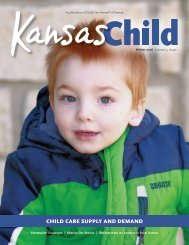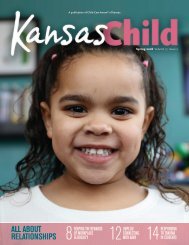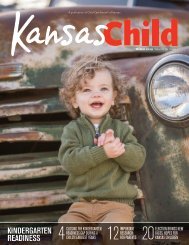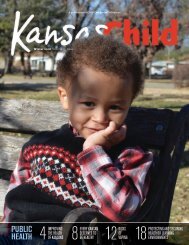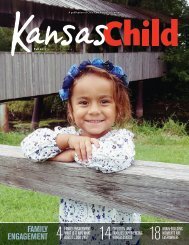2019 Fall Kansas Child
You also want an ePaper? Increase the reach of your titles
YUMPU automatically turns print PDFs into web optimized ePapers that Google loves.
I Have
NOW
Completed a
Self-Assessment,
What do I do?
BY TANYA BULLUCK
You have completed a self-assessment
on your early childhood program; now
what do you do with the information you
have obtained from the process?
Self-assessments are the initial step in
examining and identifying how to progress
with implementing and nurturing quality
improvements throughout your early childhood
program. The valuable information
you now hold has helped you to determine
what you are doing well, and what areas have
been identified that need some improvement.
Some areas for improvement might
need to be followed up with immediate
modifications being completed, especially
if they are a health-and-safety issue. Other
improvements can be reflected upon, strategically
thought out and applied over time.
By enhancing your program, you will increase
the quality in the lives of the young
children, and the families you support.
Now, it is time to take these areas for improvements
and turn them into a quality
improvement plan (QIP).
A QIP is a document used to assist early
childhood educators in planning for goals
and improvements, to help create a quality,
early learning environment for young children
and their families.
A QIP should not only include the
early childhood educator’s ideas
and opinions, but it should
also include all those who
are voices in these children’s
lives. Some of the
most well-thought-out
quality improvement
plans include the children,
their families, staff members,
community members
and any other partner interested
in supporting the health
and well-being of young children. This
is a collaborative effort that does not stop
once you have created the plan. Your QIP
is an essential tool in creating a continuous
journey towards quality goals and improvements.
It is important to remember that it is not
the length of your plan, or the amount of
time you have put into it, it’s more about
the achievable goals and quality you have
put into implementing your plan. This
plan should be an ongoing and progressing
document, with the opportunity to modify
along with the ever-changing early childhood
atmosphere. As you move through
this personal and professional growth process,
you will reflect and revise your plan
as needed. Once you review your plan and
see that your past areas for improvement
have begun to turn into your strengths,
you can then begin to look at other areas
for improvement and revise your QIP. Remember
that your goals can be short- and/
or long-term, so long as you keep in mind
that all of your goals are just as important
to achieve as the other.
Self-assessments followed up by creating
a quality improvement plan are an essential
piece in your personal and professional
growth. Much of what a child needs to be
successful in life begins during these early
years of development. By taking the time
to evaluate yourself and develop a plan, you
are building an environment that is indispensable
in providing quality outcomes for
children and families.
TANYA BULLUCK
Program Director, Child
Care Aware of Kansas,
Region 2
Tanya Bulluck is the Program
Director at Child Care Aware of
Kansas, Region 2, located at Child
Start, in Wichita. She holds a Master’s
degree in Leadership and an undergraduate
degree in Organizational Leadership. She
serves on the KSAEYC board and is an adjunct
professor for Butler Community College’s Early
Childhood Education Department.
10
A Publication of Child Care Aware ® of Kansas











